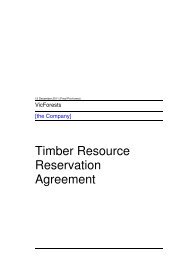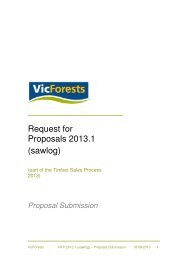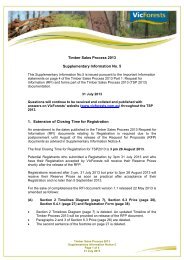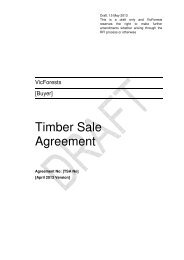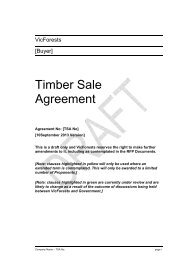Module 5 - VicForests
Module 5 - VicForests
Module 5 - VicForests
Create successful ePaper yourself
Turn your PDF publications into a flip-book with our unique Google optimized e-Paper software.
FOREST AUDIT PROGRAM TOOLBOX<br />
2.5 ROADING<br />
Roads built in State forests for timber harvesting operations have the potential to<br />
create environmental impacts, particularly on water quality and river health.<br />
The Code aims to protect a range of environmental values while allowing safe and<br />
economic roading for timber production by ensuring that the planning and<br />
management of permanent and temporary roads for timber cartage and machinery<br />
transport is fit for purpose, protects environmental and cultural values, and the safety<br />
of all road users.<br />
The audit will need to assess the following:<br />
• Road Planning, to ensure the location and construction of new and upgraded<br />
roads minimise risks to environmental values;<br />
• Road Design, to minimise construction and maintenance costs, reduce<br />
environmental risk such as impacts to water quality, improve efficiency of haulage<br />
operations, and ensure public safety is maintained;<br />
• Road Construction is conducted in a manner consistent with plans and designed<br />
to ensure fitness for use, public safety, the protection of water quality and river<br />
health, Aboriginal and other significant cultural heritage and biodiversity<br />
conservation values;<br />
• Road Maintenance minimises erosion and to protect water quality;<br />
• Suspension of Cartage, to ensure wet weather or other adverse conditions don’t<br />
affect the road surface and drainage doesn’t compromise water quality and public<br />
safety; and<br />
• Road Closures are permanent and effectively drained.<br />
2.6 COUPE INFRASTRUCTURE<br />
Coupe infrastructure includes log landings and dumps, snigging and forwarding<br />
tracks.<br />
The area of coupe infrastructure required to meet timber production needs must be<br />
minimized without compromising safety. In-coupe infrastructure must be located,<br />
constructed and maintained to minimise potential adverse impacts on soil and water<br />
quality, and Aboriginal cultural heritage.<br />
At the conclusion of harvesting operations all coupe infrastructure must be<br />
rehabilitated to standards specified in the Code, The Management Procedures for<br />
Timber Harvesting, Roading and Regeneration in Victoria’s State Forests, 2009 (the<br />
Management Procedures) and the relevant Forest Management Plan (FMP).<br />
FOREST AUDIT PROGRAM – MODULE 5 HARVESTING AND CLOSURE PAGE 10




